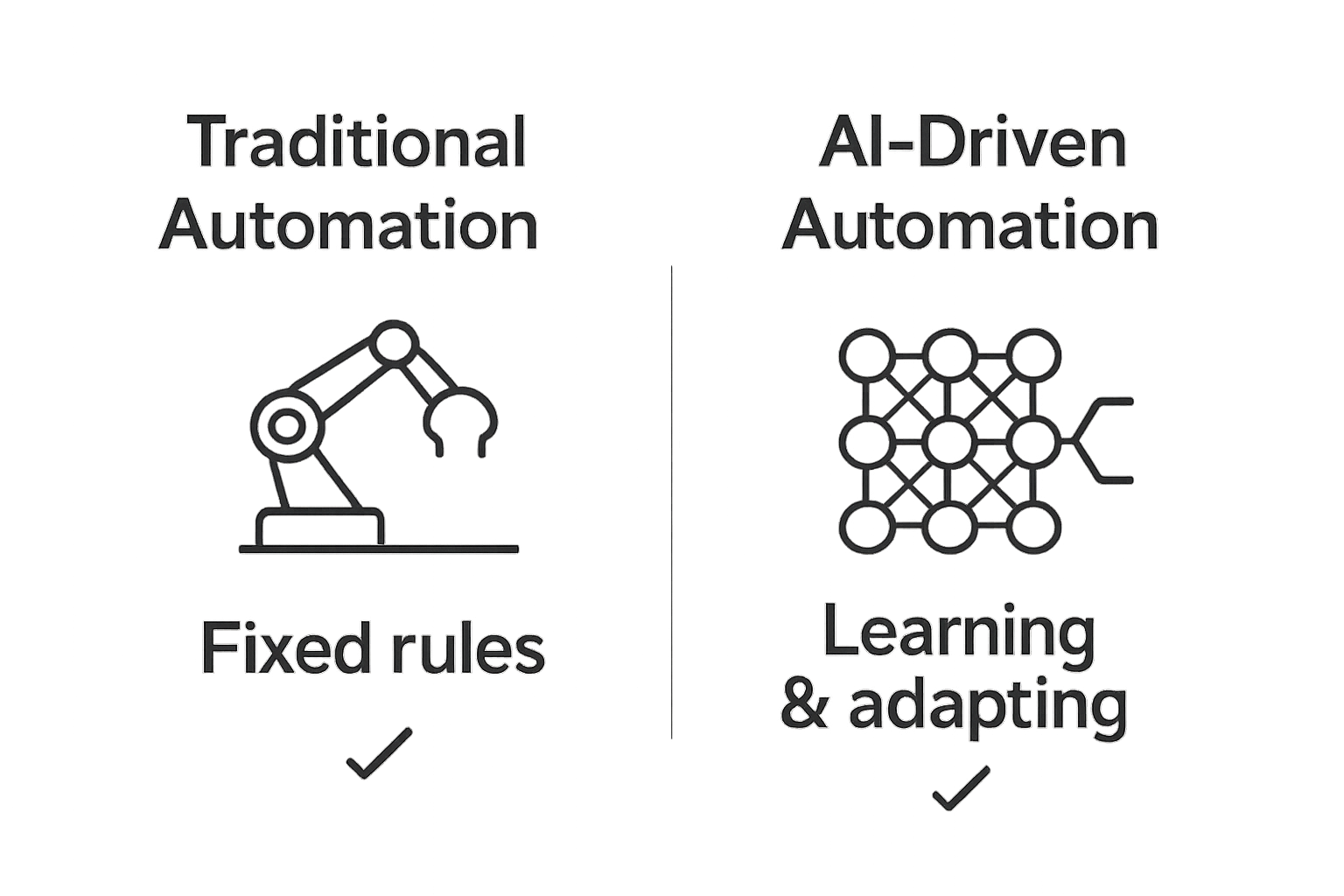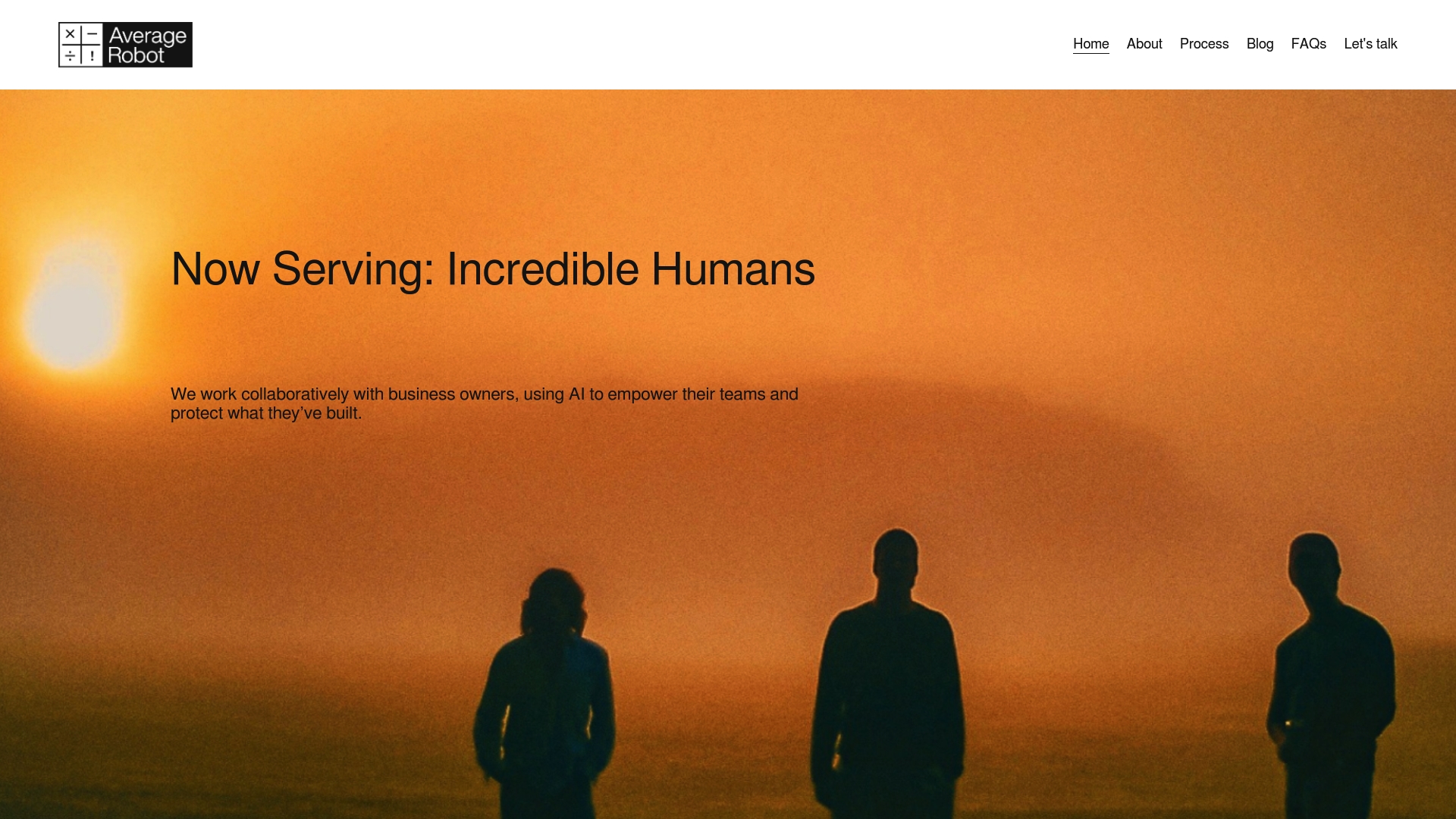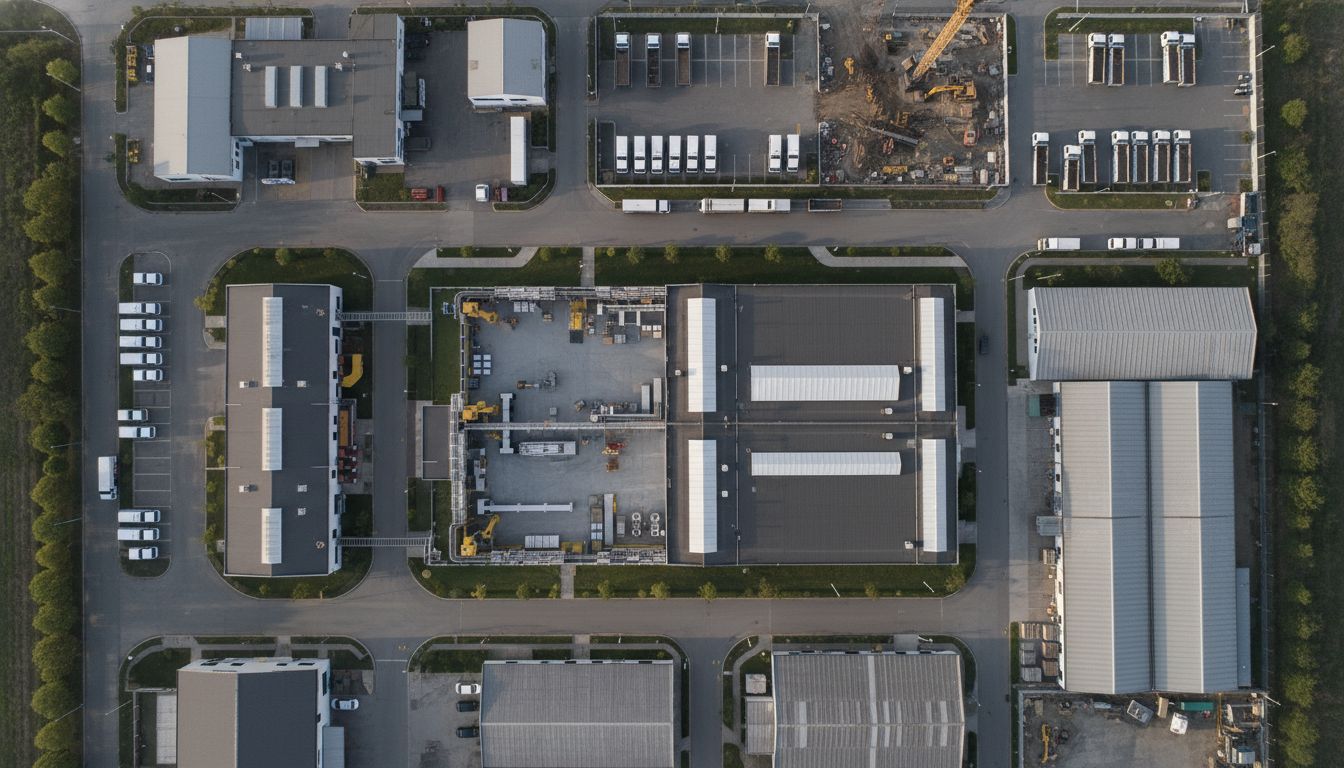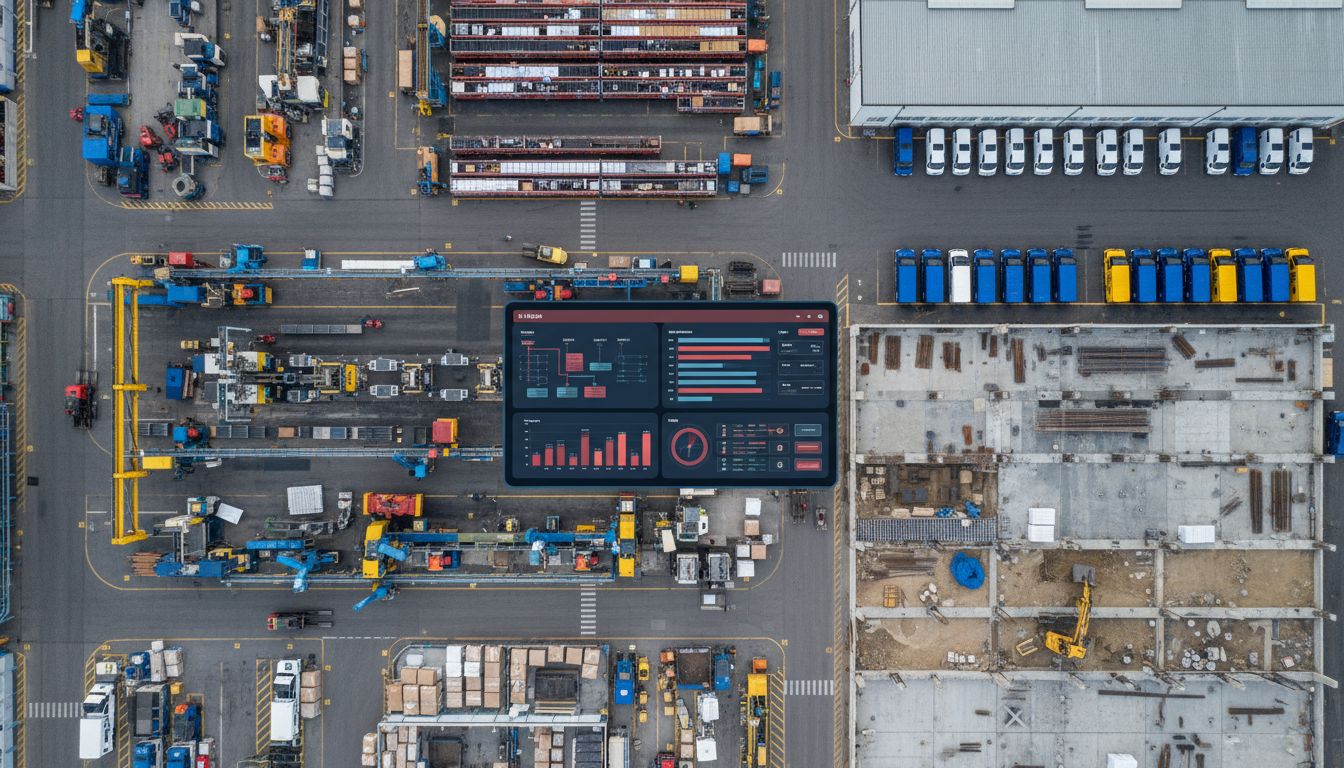Understanding Defining AI-Driven Automation: Your Guide

AI-driven automation is changing the way companies run their operations and plan for the future. The biggest surprise? These intelligent systems are now adapting and learning in real time instead of just repeating fixed tasks, making old-fashioned automation look ancient. Instead of robots taking over jobs, businesses are now using AI to work side-by-side with people and make teams smarter and more creative than ever.
Table of Contents
- What Is Ai-Driven Automation?
- Why Ai-Driven Automation Matters For Businesses
- How Ai-Driven Automation Works: Key Concepts Explained
- Real-World Applications Of Ai-Driven Automation
- Future Trends In Ai-Driven Automation
Quick Summary
| Takeaway | Explanation |
|---|---|
| AI-Driven Automation Enhances Traditional Processes | It employs artificial intelligence to improve flexibility and decision-making beyond rigid rules. |
| Dynamic Learning Enables Continuous Improvement | Systems learn from historical data to optimize their performance over time and adapt strategies. |
| AI Should Augment, Not Replace Human Roles | The goal is to empower human workers by automating routine tasks and allowing focus on strategic initiatives. |
| Critical for Competitive Advantage | Organizations leveraging AI-driven automation can enhance performance, agility, and operational efficiency in the market. |
| Strategic Implementation is Essential | Successful integration requires aligning AI tools with business goals and maintaining human oversight. |
What is AI-Driven Automation?
AI-driven automation represents a transformative technological approach where artificial intelligence enhances traditional automation processes, enabling systems to perform tasks with unprecedented intelligence and adaptability. Unlike conventional automation that follows rigid pre-programmed rules, AI-driven automation introduces cognitive capabilities that allow machines to learn, interpret complex scenarios, and make autonomous decisions.
Understanding the Core Mechanism
At its fundamental level, AI-driven automation combines advanced algorithms, machine learning models, and data processing capabilities to create intelligent systems that can adapt and evolve. These systems go beyond simple repetitive task execution by incorporating contextual understanding and predictive capabilities.

According to Oklahoma State University, AI-driven automation enables machines to interpret sensor data, understand surrounding environments, and independently infer task requirements. This means robots and software can now analyze situations in real-time, adjust strategies, and optimize performance without constant human intervention.
Key Characteristics of AI-Driven Automation
The distinguishing features of AI-driven automation include:
- Dynamic Learning: Systems continuously improve performance by analyzing past outcomes and adjusting strategies
- Contextual Intelligence: Ability to understand nuanced scenarios beyond binary rule sets
- Predictive Capabilities: Anticipating potential challenges and proactively developing solutions
For business owners, this technological advancement represents more than just efficiency. It signifies a strategic tool for transforming operational workflows, reducing human error, and creating space for teams to focus on higher-value strategic initiatives. The goal is not to replace human workers but to empower them with intelligent tools that handle routine, complex tasks more effectively.
Implementing AI-driven automation requires a thoughtful approach where human expertise remains central to designing and guiding these intelligent systems. Successful integration means viewing AI as a collaborative partner that amplifies human capabilities rather than a standalone replacement for human intelligence.
Why AI-Driven Automation Matters for Businesses
Businesses increasingly recognize AI-driven automation as a critical strategic tool for maintaining competitive advantage in a rapidly evolving technological landscape. This approach goes beyond mere technological implementation, representing a fundamental transformation in how organizations operate, innovate, and deliver value.
Strategic Business Advantages
AI-driven automation offers profound strategic benefits that extend far beyond operational efficiency. By integrating intelligent systems, businesses can unlock new levels of performance, strategic insight, and organizational agility. Intelligent automation transforms traditional workflows by enabling real-time decision making, predictive analytics, and adaptive problem solving.
According to Baker College, AI technologies enhance critical business functions including:
- Customer Service: Implementing intelligent chatbots and responsive communication systems
- Product Development: Using predictive models to forecast market demand and accelerate innovation
- Quality Control: Advanced monitoring and proactive performance management
Competitive Transformation
The true value of AI-driven automation lies not in replacing human workers, but in creating an environment where human creativity and technological intelligence collaborate seamlessly. Businesses that strategically implement these technologies can:
- Dramatically reduce operational costs
- Increase precision and consistency in complex tasks
- Generate deeper insights from complex data ecosystems
- Free human talent to focus on high-value strategic initiatives
For mid-tier businesses with $20 million+ annual recurring revenue, AI-driven automation represents a powerful mechanism to optimize existing processes, uncover hidden efficiencies, and position themselves at the forefront of technological innovation. The key is viewing AI not as a replacement technology, but as an intelligent augmentation tool that amplifies human potential and drives sustainable competitive advantage.
How AI-Driven Automation Works: Key Concepts Explained
AI-driven automation operates through sophisticated technological frameworks that transform raw data into intelligent, adaptive systems capable of complex decision making. By combining advanced algorithms, machine learning techniques, and robust data processing capabilities, these systems create a new paradigm of technological intelligence.
Core Technological Mechanisms
At the heart of AI-driven automation are intricate computational processes that enable machines to perceive, learn, and respond to complex environmental inputs. These mechanisms leverage neural networks, probabilistic models, and sophisticated algorithms that mimic human cognitive processes while dramatically exceeding human computational capabilities.
According to The Brookings Institution, the fundamental technologies enabling AI-driven automation include:
This table summarizes the key technological mechanisms that enable AI-driven automation to perform with intelligence and adaptability.
| Core Mechanism | Description |
|---|---|
| Neural Networks | Computational systems modeled after the human brain, enabling pattern recognition and learning from data |
| Natural Language Processing | Allows machines to interpret and respond to human language, supporting communication and understanding |
| Predictive Analytics | Uses advanced statistical techniques to forecast outcomes and drive informed decisions across various scenarios |
- Neural Networks: Computational systems modeled after human brain structures
- Natural Language Processing: Enabling machines to understand and interpret human communication
- Predictive Analytics: Advanced statistical techniques for forecasting potential outcomes
Operational Intelligence Lifecycle
The operational intelligence lifecycle in AI-driven automation follows a sophisticated, cyclical process:

- Data Collection: Gathering information from multiple sources and sensor networks
- Pattern Recognition: Identifying complex correlations and potential insights within collected data
- Decision Generation: Creating probabilistic recommendations based on recognized patterns
- Continuous Learning: Refining algorithms and models through ongoing performance feedback
This approach transforms traditional automation from rigid, rule-based systems into dynamic, adaptive platforms that can understand context, learn from experiences, and make increasingly sophisticated decisions. For business leaders, understanding these mechanisms is crucial to recognizing AI-driven automation not as a replacement for human intelligence, but as a powerful collaborative tool that amplifies human strategic capabilities.
Real-World Applications of AI-Driven Automation
AI-driven automation has transcended theoretical potential, emerging as a transformative force across multiple industries. By integrating intelligent technologies into existing workflows, businesses are redefining operational efficiency, decision-making processes, and strategic capabilities.
Industry-Specific Transformations
Intelligent automation is rapidly revolutionizing traditional business models by providing adaptive, context-aware solutions that go beyond simple task execution. Organizations are discovering that AI-driven technologies can solve complex challenges with unprecedented precision and speed.
According to The National Institute of Standards and Technology, AI-driven automation is creating significant impacts across critical sectors:
- Manufacturing: Implementing advanced quality control and predictive maintenance systems
- Healthcare: Developing AI-enabled diagnostic tools and personalized treatment protocols
- Transportation: Creating autonomous navigation and logistics optimization platforms
Strategic Implementation Frameworks
Successful AI-driven automation requires more than technological integration. It demands a strategic approach that aligns technological capabilities with specific business objectives. This means understanding that AI is not a standalone solution, but a collaborative tool designed to enhance human expertise.
Key implementation strategies include:
- Identifying precise operational challenges where AI can provide measurable improvements
- Developing robust change management protocols
- Creating continuous learning frameworks that allow systems to adapt and improve
- Maintaining human oversight and strategic direction
By viewing AI-driven automation as a strategic partnership between human intelligence and technological capability, businesses can unlock transformative potential that extends far beyond traditional automation approaches. The goal is not replacement, but augmentation—using intelligent systems to amplify human creativity, strategic thinking, and operational effectiveness.
Future Trends in AI-Driven Automation
The landscape of AI-driven automation is rapidly evolving, presenting unprecedented opportunities for businesses to reimagine operational strategies, enhance decision-making capabilities, and create more intelligent, adaptive technological ecosystems. As we look toward the future, emerging trends suggest a profound transformation in how organizations leverage artificial intelligence.
Emerging Technological Paradigms
Hyper-automation represents the next frontier of intelligent systems, where multiple machine learning, packaged software, and automation tools converge to create increasingly sophisticated technological solutions. This approach goes beyond traditional automation by integrating advanced technologies that can learn, adapt, and make complex decisions with minimal human intervention.
According to the American Institute of Leadership, Innovation & Technology, key emerging trends include:
- Decision Intelligence: AI systems that provide contextual, predictive insights
- Augmented Workforce: Technologies that enhance human capabilities rather than replace them
- Ethical AI Development: Frameworks ensuring responsible and transparent AI implementation
Strategic Transformation Vectors
The future of AI-driven automation is not about technological replacement, but about creating symbiotic relationships between human creativity and machine intelligence. Organizations that successfully navigate this transition will focus on:
- Developing robust AI governance frameworks
- Investing in continuous skill development for teams
- Creating adaptive technological infrastructures
- Maintaining a human-centric approach to technological innovation
Businesses must view AI-driven automation as a strategic partner that amplifies human potential, transforms operational capabilities, and creates new pathways for innovation. The most successful organizations will be those that understand AI not as a standalone technology, but as an integrated approach to solving complex business challenges with unprecedented intelligence and adaptability.
Transform Insight Into Action With Average Robot
Struggling to unlock the real value of AI-driven automation for your business? If the complexity and uncertainty described in our article feel all too familiar, you are not alone. Many mid-tier business owners face the challenge of integrating adaptive, intelligent systems while keeping strategic control and clarity. Average Robot understands that you need a partner—not just more technical jargon. We help you bridge the gap between theoretical AI concepts and practical business results by putting your goals and your team’s expertise at the center of every solution.

Ready to implement AI without the overwhelm? Visit Average Robot to access tailored roadmaps, proven automation playbooks, and step-by-step team engagement strategies. Let our experts guide you with straightforward, actionable support so you can automate repetitive tasks, boost team morale, and position your business for future growth. Take action now to turn strategic AI insights into a measurable competitive advantage with our collaborative approach. Start your journey today at Average Robot.
Frequently Asked Questions
What is AI-driven automation?
AI-driven automation is a technological approach where artificial intelligence enhances traditional automation processes, allowing systems to perform tasks with intelligence and adaptability rather than following rigid pre-programmed rules.
How does AI-driven automation benefit businesses?
AI-driven automation helps businesses improve efficiency, reduce operational costs, enhance decision-making through predictive analytics, and allow human workers to focus on higher-value strategic tasks by automating complex and routine functions.
What are the key characteristics of AI-driven automation?
The key characteristics include dynamic learning, contextual intelligence, and predictive capabilities, which enable systems to adapt, understand nuanced scenarios, and anticipate potential challenges in real-time.
How is AI-driven automation different from traditional automation?
Unlike traditional automation, which relies on fixed rules and processes, AI-driven automation utilizes advanced algorithms and machine learning to allow systems to learn from data, interpret complex situations, and make autonomous decisions, leading to greater adaptability and intelligence.
To help distinguish between traditional automation and AI-driven automation, here is a side-by-side comparison of their core characteristics and capabilities.
| Feature | Traditional Automation | AI-Driven Automation |
|---|---|---|
| Rule Structure | Fixed, pre-programmed rules | Adaptive, learns from data |
| Task Flexibility | Limited to repetitive, predictable tasks | Can handle complex, dynamic scenarios |
| Decision-Making | Follows set logic | Makes autonomous, intelligent decisions |
| Learning Capability | None | Yes—continuously improves |
| Human Role | Often requires manual intervention | Augments human workers, collaborative |
| Contextual Understanding | None | High—interprets nuanced situations |
| Predictive Ability | None | Uses analytics for forecasting |
Recommended
- 5 Costly Mistakes Businesses Make When Implementing AI…What Successful Business Owners Do Differently. — Average Robot
- About | Discover Opportunities - Schedule Today — Average Robot
- AI and Leadership: What Owners Should Focus On — Average Robot
- The Human + AI Equation: Where People Still Matter Most — Average Robot
- The Impact of AI on SEO in 2025: Key Changes for Businesses




